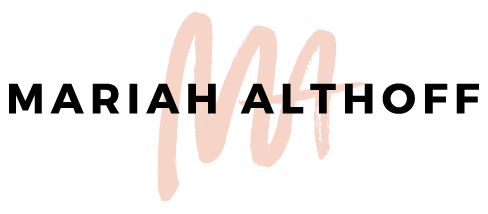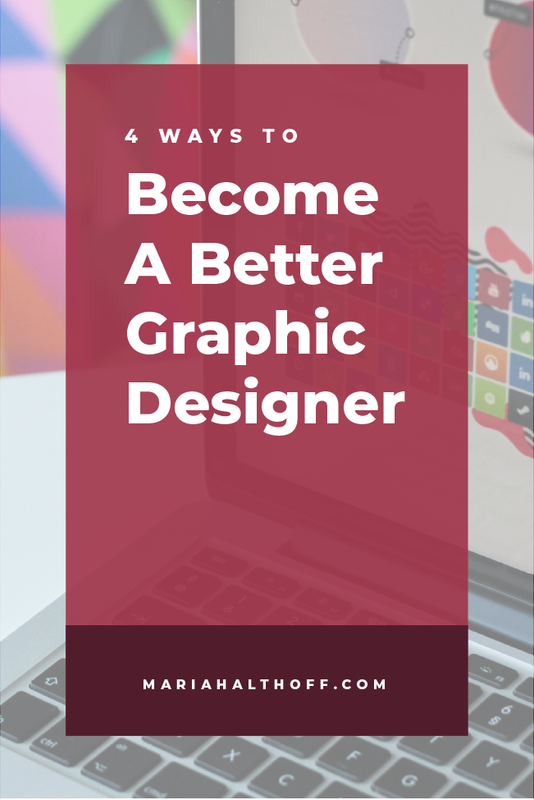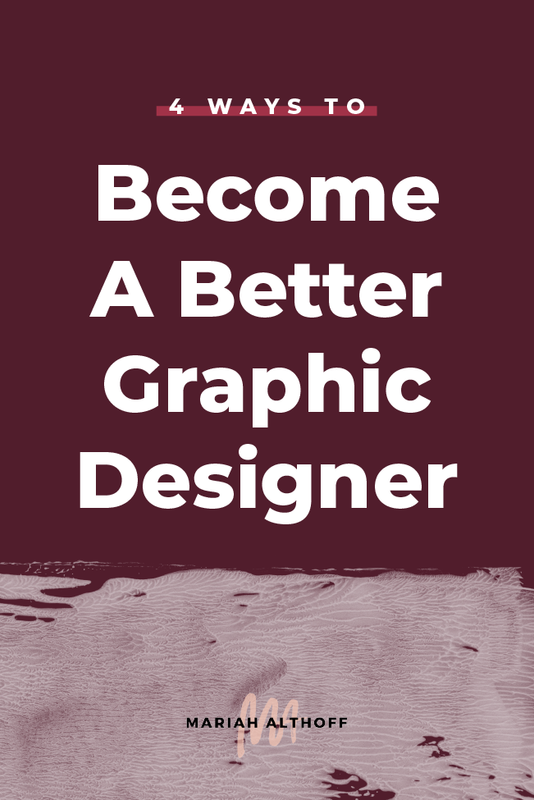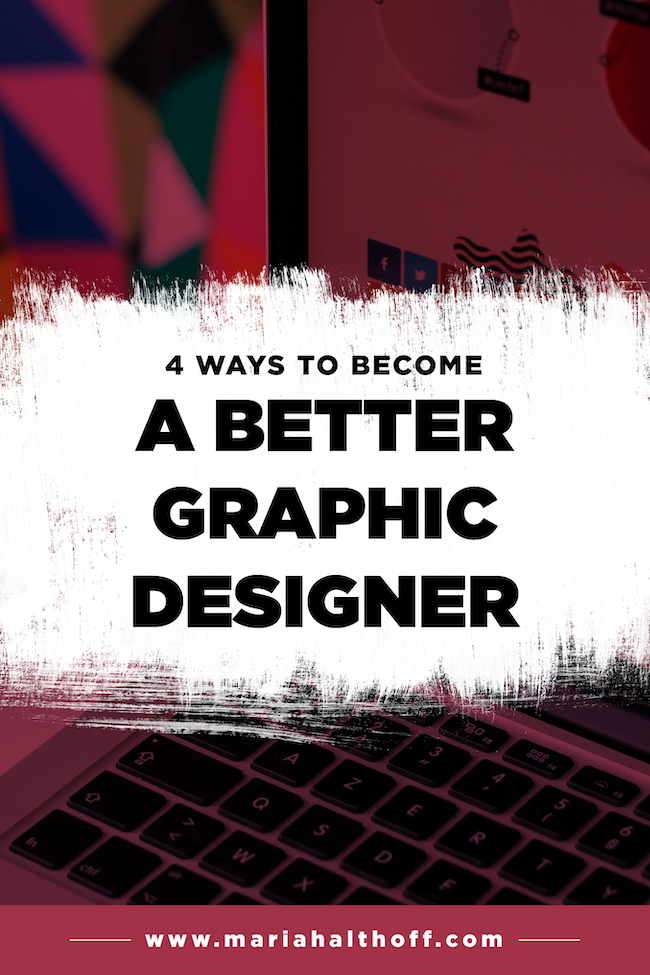4 Ways to Become a Better Graphic Designer
In hindsight, this is embarrassing to admit, but in college, I thought I was a pretty good designer.
To be fair in several of my classes, I was among some the better designers. But, looking back on my work now, I CRINGE.
I’m talking shrivel-up-and-die-inside-cringe because my work was so terrible at the time.
But friends, I’m here to tell you that every story has a silver lining, because this one has taught me a valuable lesson – always keep learning and growing as a designer, because look how far I’ve come in just 5 years!
With that being said though, I do still get what I like to call "designer-envy” – a very contagious infection among the graphic design community that attacks your brain and causes you to constantly compare yourself to other designers that are better than you. A few of the major symptoms of this disease are: lack of confidence, jealousy, envy, and wanting to light a fire to your entire portfolio and start over.
I first want to assure you that you’re not alone in catching this. Everyone does – sometimes on a regular basis – no matter the level of designer. I’m telling you, it’s a HIGHLY CONTAGIOUS INFECTION. 😉
But in the same vein, I, Miss Silver Lining, am here to tell you that you can turn around this unhelpful comparison syndrome into INSPIRATION, and thus make you a better designer because of it.
Looking back, that’s really how I got here. I always strived to be as good as the person ahead of me. And by working toward becoming a better designer, I eventually got there and then was measuring my work against the next person in line. A bit of friendly competition isn’t always a bad thing, right? And today, I want to tell you four ways I’ve personally used this to advance my graphic design skills and drastically improve my work over time (and continue to do so!).
Surround yourself with good design
This one is huge you guys. The more you spend studying, noticing, and engaging with good design, the better you’ll be as a designer.
I’m serious – it’s that simple.
I grew THE MOST as a designer in my first year out of school because I was constantly surrounded by good design and better designers.
Just from all of the design work hanging around the office, the edits to past projects I’d work on, and from being around designers that were better than I was, I was able to learn SO much about being a better designer. All because it was in my face all the time and therefore, I was able to pick up on smaller details that the average person would just glance over, when in fact, it’s those details are what elevate your designs more than you could ever realize.
For example, I learned quickly that anybody text that was printed larger than 10pt looked amateur.
I learned how important whitespace was and to be extra mindful of cluttering my page.
I learned what fonts were modern and trendy (and more so, which ones weren’t) and how to identify them and pair them with other fonts.
I could go on and on and on about this guys. Surrounding yourself with good design is the single best way to improve your design skills. It was (and still is) for me anyway!
If you’re really serious about becoming a better designer, take 20 minutes of your day every day and look at good design from other designers. Notice and take notes of what makes it a good design – which fonts they use, how they position elements, how they organize the layout of the page, how they keep the design from looking cluttered, what types of effects are used, etc.
The more you’re able to spend time with good design, the more you’ll pick up on all of these traits, and eventually begin to draw parallels between multiple designs and styles you study.
So where can you go to look for good designs? Here’s a good list:
Pinterest
Pinterest is my holy grail for finding graphic designs. I use it to collect tons of inspiration for almost every project I work on. Keep in mind that not all designs on Pinterest are good designs, however, the pins that are at the top of the feed are typically the projects that have been repinned the most, and therefore are designs that appeal to a large audience and are probably pretty good. Put together your own design inspiration boards and collect all your favorite designs where you can go back and look at again anytime you want. If you need a place to start, check out my Pinterest profile! I have more graphic design pins on there than I’d like to admit.Instagram
I am pretty terrible at adding my portfolio to Instagram, however, there are so many designers who aren’t. Lately, I’ve been filling my Instagram feed with graphic designers I admire and it’s been so inspiring to sift through every day! Start searching for some graphic design hashtags and follow any and all design accounts that inspire you. You’ll get a daily dose of design every time you open Instagram (which if you’re anything like me is one trillion times per day).Dribbble
Dribbble (yes with three b’s – I know it confuses me too) is a design portfolio site where graphic designers will upload their work to be displayed. There is some great work on there that you’ll definitely be able to learn from and be inspired by. You can even pin some of your favorite Dribbble designs to your new Pinterest board that you put together!Behance
Behance is also a design portfolio website that’s much larger and diverse than Dribbble – which sometimes can feel a bit more overwhelming because of how much stuff is on there. Nonetheless, there are some crazy talented designers that use Behance to display their portfolio and it’s such a great resource when you’re looking to learn by example!
Recreate existing projects
You know what they say – practice makes perfect! And sometimes the best way to learn about design is to replicate a project that really stands out to you. In doing so, you’re able to have some muscle memory behind both the technical skills it takes to create a certain design, as well as the conceptual side of design (ie. placing objects a certain distance apart or pairing two compatible fonts).
I’m not saying that you should rip someone else’s design off. Obviously, once you’ve replicated a design you’re not able to use it as your own (ya know, copyright infringement), but you are able to use it as a tool for learning new skills and techniques. Think of this as your own self-study tutorial that you’ll learn a ton from in the process, even though you won’t be able to use the final product for anything of your own.
Once you’ve replicated a certain design, go ahead and come up with your own design concept and implement what you’ve learned from the practice project! THEN you’ll be able to use your original concept in your portfolio if you so choose.
Specialize in a style
In your quest to surround yourself with good design and maybe even replicate some projects you love, you may be realizing that you’ve started to gravitate towards a specific style.
For me, that style is modern, clean, cleaver, and minimalist. For you that could be anything – feminine and flowy, vintage and hipster-y, classic and timeless, etc.
The point is, notice what aesthetic you’re more drawn to, and start specializing in it. How do you specialize in a style? You start creating a ton of graphics that fit in that aesthetic until it becomes second nature.
For me, even when I try to branch outside of my modern, minimalist aesthetic, it’s still very much an underlying influence in every graphic I create.
Once you’ve niched your design style into a particular aesthetic, it's easier for you to become really good at one type of design. Having a specific design style is also a great way to book clients. Anyone who is looking for or is drawn to your design aesthetic is going to be more likely to book you if you have tons of portfolio examples within their desired look and feel.
The key is to get really good at one thing rather than spread yourself thin and be mediocre at everything.
Master ONE program at a time
Speaking of getting really good at one design style, this theory also holds true for design programs.
There is SO much you can learn in the Adobe Creative Suite. Like you could spend your whole life studying each program and still find something you didn’t know how to do. It’s seriously crazy how robust they all are.
This is why I recommend focusing on one program to get REALLY good at.
Pick a program that suits your most common design needs or client requests, and get SUPER good at it. Once you’ve mastered one program, it’s way easier to figure out the other two programs for the random times you’ll need to use them. This will also give you way more confidence as a designer and it will give you a great foundation to build upon as you continue on your design path.
Which program should you choose to master? That depends on the type of work you do.
InDesign is great for text-heavy documents – booklets, ebooks, brochures, interactive PDFs, etc.
Photoshop is ideal for photo editing, product mockups, web graphics, and GIFs.
Illustrator is the best choice for logo design, vector graphics, icons, print design AND web design, illustrations, etc.
If you’re doing a little bit of everything, Illustrator is definitely the most versatile and covers the most ground out of the three programs.
Related Post –>> Why I Use Adobe Illustrator Instead of Photoshop























